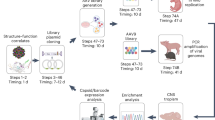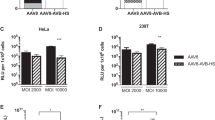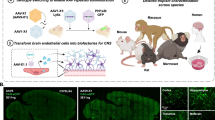Abstract
Vascular-targeted gene therapies have the potential to treat many of the leading causes of mortality in the western world. Unfortunately, these therapies have been ineffective due to poor vascular gene transfer. The use of alternative virus serotypes and the incorporation of vascular targeting ligands into vectors has resulted in only modest increases in vascular gene transfer. Adeno-associated virus (AAV) 1 has shown the most promise among the AAV vectors for the transduction of vascular endothelial cells. However, no straightforward small-scale purification strategy exists for AAV1 as it does for AAV2 making it difficult to quickly produce AAV1 vector for analysis. Here we have combined two AAV1 capsid protein modifications to enhance vascular gene transfer and allow easy purification of vector particles. Mosaic vector particles have been produced comprised of capsid proteins containing the well-characterized RGD4C modification to target integrins present on the vasculature, and capsid proteins containing a modification that permits metabolic biotinylation and efficient purification of mosaic particles by avidin affinity chromatography. We show that the RGD modification results in a 50–100-fold enhancement in endothelial cell gene transfer that is maintained in biotinylated mosaic AAV1 particles. These results suggest that mosaic virions hold significant promise for targeted gene delivery to the vasculature.
This is a preview of subscription content, access via your institution
Access options
Subscribe to this journal
Receive 12 print issues and online access
$259.00 per year
only $21.58 per issue
Buy this article
- Purchase on Springer Link
- Instant access to full article PDF
Prices may be subject to local taxes which are calculated during checkout





Similar content being viewed by others
References
Bartlett JS, Kleinschmidt J, Boucher RC, Samulski RJ . Targeted adeno-associated virus vector transduction of nonpermissive cells mediated by a bispecific F(ab’gamma)2 antibody. Nat Biotechnol 1999; 17: 181–186.
Samulski RJ, Sally M, Muzyczka N . Adeno-associated viral vectors. In: Friedmann T (ed). The Development of Human Gene Therapy. Cold Spring Harbor Laboratory Press: Cold Spring Harbor, 1999, pp 131–172.
Bartlett JS, Samulski RJ, McCown TJ . Selective and rapid uptake of adeno-associated virus type 2 in brain. Hum Gene Ther 1998; 9: 1181–1186.
Halbert CL, Standaert TA, Aitken ML, Alexander IE, Russell DW, Miller AD . Transduction by adeno-associated virus vectors in the rabbit airway: efficiency, persistence, and readministration. J Virol 1997; 71: 5932–5941.
Qing K, Khuntirat B, Mah C, Kube DM, Wang XS, Ponnazhagan S et al. Adeno-associated virus type 2-mediated gene transfer: correlation of tyrosine phosphorylation of the cellular single-stranded D sequence-binding protein with transgene expression in human cells in vitro and murine tissues in vivo. J Virol 1998; 72: 1593–1599.
Teramoto S, Bartlett JS, McCarty D, Xiao X, Samulski RJ, Boucher RC . Factors influencing adeno-associated virus-mediated gene transfer to human cystic fibrosis airway epithelial cells: comparison with adenovirus vectors. J Virol 1998; 72: 8904–8912.
Pajusola K, Gruchala M, Joch H, Luscher TF, Yla-Herttuala S, Bueler H . Cell-type-specific characteristics modulate the transduction efficiency of adeno-associated virus type 2 and restrain infection of endothelial cells. J Virol 2002; 76: 11530–11540.
Muzyczka N . Use of adeno-associated virus as a general transduction vector for mammalian cells. Curr Top Microbiol Immunol 1992; 158: 97–129.
Qing K, Mah C, Hansen J, Zhou S, Dwarki V, Srivastava A . Human fibroblast growth factor receptor 1 is a co-receptor for infection by adeno-associated virus 2. Nat Med 1999; 5: 71–77.
Summerford C, Bartlett JS, Samulski RJ . AlphaVbeta5 integrin: a co-receptor for adeno-associated virus type 2 infection. Nat Med 1999; 5: 78–82.
Summerford C, Samulski RJ . Membrane-associated heparan sulfate proteoglycan is a receptor for adeno-associated virus type 2 virions. J Virol 1998; 72: 1438–1445.
Bartlett JS, Wilcher R, Samulski RJ . Infectious entry pathway of adeno-associated virus and adeno-associated virus vectors. J Virol 1999; 74: 2777–2785.
Chen S, Kapturczak M, Loiler SA, Zolotukhin S, Glushakova OY, Madsen KM et al. Efficient transduction of vascular endothelial cells with recombinant adeno-associated virus serotype 1 and 5 vectors. Hum Gene Ther 2005; 16: 235–247.
Shi W, Arnold GS, Bartlett JS . Insertional mutagenesis of the adeno-associated virus type 2 (AAV2) capsid gene and generation of aav2 vectors targeted to alternative cell-surface receptors. Hum Gene Ther 2001; 12: 1697–1711.
Shi W, Bartlett JS . RGD inclusion in VP3 provides adeo-associated virus type 2 (AAV2)-based vectors with a heparan sulfate-independent cell entry mechanism. Mol Ther 2003; 7: 515–525.
Arnold GS, Sasser AK, Bartlett JS . Metabolic biotinylation provides a unique platform for the purification and targeting of different serotype AAV vectors. Mol Ther 2006, submitted.
Rabinowitz JE, Rolling F, Li C, Conrath H, Xiao W, Xiao X et al. Cross-packaging of a single adeno-associated virus (AAV) type 2 vector genome into multiple AAV serotypes enables transduction with broad specificity. J Virol 2002; 76: 791–801.
Xiao X, Li J, Samulski R . Production of high-titer recombinant adeno-associated virus vectors in the absence of helper adenovirus. J Virol 1998; 72: 2224–2232.
Zolotukhin S . Recombinant adeno-associated virus purification using novel methods improves infectious titer and yield. Gene Therapy 1999; 6: 973–985.
Clark KR, Liu X, McGrath JP, Johnson PR . Highly purified recombinant adeno-associated virus vectors are biologically active and free of detectable helper and wild type viruses. Hum Gene Ther 1999; 10: 1031–1039.
Clark K, Voulgaropoulou F, Johnson P . A stable cell line carrying adenovirus-inducible rep and cap genes allows for infectivity titration of adeno-associated virus vectors. Gene Therapy 1996; 3: 1124–1132.
Davidoff AM, Ng CY, Sleep S, Gray J, Azam S, Zhao Y et al. Purification of recombinant adeno-associated virus type 8 vectors by ion exchange chromatography generates clinical grade vector stock. J Virol Methods 2004; 121: 209–215.
Kaludov N, Handelman B, Chiorini JA . Scalable purification of adeno-associated virus type 2, 4, or 5 using ion-exchange chromatography. Hum Gene Ther 2002; 13: 1235–1243.
Smith RH, Ding C, Kotin RM . Serum-free production and column purification of adeno-associated virus type 5. J Virol Methods 2003; 114: 115–124.
Zolotukhin S, Potter M, Zolotukhin I, Sakai Y, Loiler S, Fraites Jr TJ et al. Production and purification of serotype 1, 2, and 5 recombinant adeno-associated viral vectors. Methods 2002; 28: 158–167.
Rabinowitz JE, Bowles DE, Faust SM, Ledford JG, Cunningham SE, Samulski RJ . Cross-dressing the virion: the transcapsidation of adeno-associated virus serotypes functionally defines subgroups. J Virol 2004; 78: 4421–4432.
Gigout L, Rebollo P, Clement N, Warrington Jr KH, Muzyczka N, Linden RM et al. Altering AAV tropism with mosaic viral capsids. Mol Ther 2005; 11: 856–865.
Author information
Authors and Affiliations
Corresponding author
Rights and permissions
About this article
Cite this article
Stachler, M., Bartlett, J. Mosaic vectors comprised of modified AAV1 capsid proteins for efficient vector purification and targeting to vascular endothelial cells. Gene Ther 13, 926–931 (2006). https://doi.org/10.1038/sj.gt.3302738
Received:
Revised:
Accepted:
Published:
Issue Date:
DOI: https://doi.org/10.1038/sj.gt.3302738
Keywords
This article is cited by
-
Identification of adeno-associated virus variants for gene transfer into human neural cell types by parallel capsid screening
Scientific Reports (2022)
-
Using viral vectors as gene transfer tools (Cell Biology and Toxicology Special Issue: ETCS-UK 1 day meeting on genetic manipulation of cells)
Cell Biology and Toxicology (2010)
-
Intravascularly Administered RGD-Displaying Measles Viruses Bind to and Infect Neovessel Endothelial Cells In Vivo
Molecular Therapy (2009)
-
(Strept)avidin-displaying lentiviruses as versatile tools for targeting and dual imaging of gene delivery
Gene Therapy (2009)
-
Site-specific Modification of AAV Vector Particles With Biophysical Probes and Targeting Ligands Using Biotin Ligase
Molecular Therapy (2008)



